Проверка слуха позволяет оценить правое и левое ухо на предмет потери слуха. Результаты помогут вам, ребенку и его опекуну сделать вывод о том, будут ли ребенку полезны слуховые аппараты.
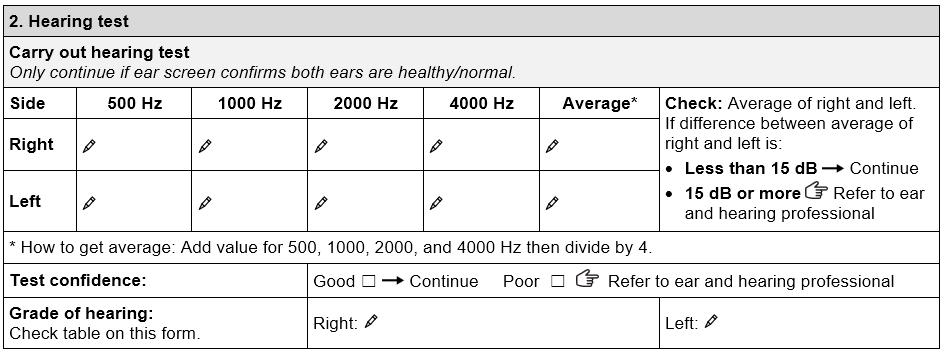
Инструкция
Обратитесь к разделу "Проверка слуха" в Форме для проведения оценки и сверьтесь с таблицей "Степень потери слуха ", чтобы выяснить, есть ли у ребенка потеря слуха.
Вопрос
Что вы можете сделать, чтобы ребенку с потерей слуха было легче понимать ваши слова?
Выберите два варианта ответа.
Если вы выбрали ответы c и d, вы правы!
Расположитесь на одном уровне с ребенком. Убедитесь в том, что ваше лицо хорошо освещено, говорите четко и медленно, чтобы ребенку было легче понять ваши слова.
Дружественный к ребенку подход
Подготовьте ребенка к проверке слуха в веселой игровой форме, используя простые слова.
Покажите оборудование, чтобы ребенку было понятно, что будет происходить во время проверки слуха.
Инструкция
Посмотрите видеоролик, в котором медицинский работник объясняет, как проходит проверка слуха, используя дружественный к детям подход.
Вопрос
Посмотрите на фотографию, где медицинский работник показывает оборудование, используя дружественный к ребенку подход.
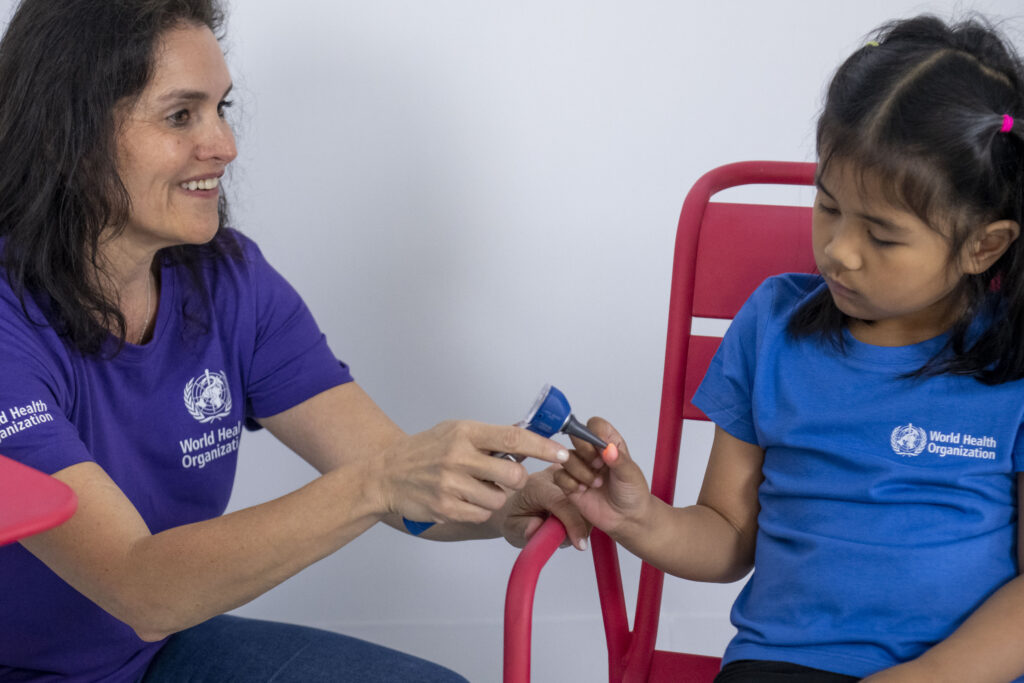
1. Что делает этот подход дружественным по отношению к ребенку?
- Сидящая сотрудница находится на уровне ребенка
- Она улыбается и смотрит на ребенка
- Она дает ребенку возможность видеть оборудование.
2. Как еще можно успокоить ребенка во время проверки слуха?
Другие способы успокоить ребенка:
- говорить приветливым тоном
- давать разъяснения в медленном темпе и проверять, насколько хорошо ребенок понял сказанное
- подбадривать ребенка, заверяя, что он отлично справляется с задачей.
Проведение проверки слуха
При проведении проверки слуха у ребенка:
- Объясните, как проходит проверка слуха
- Попрактикуйтесь в реагировании на звуки
- Проведите проверку слуха
- Рассчитайте средний порог слышимости
- Задокументируйте результаты по каждому уху.
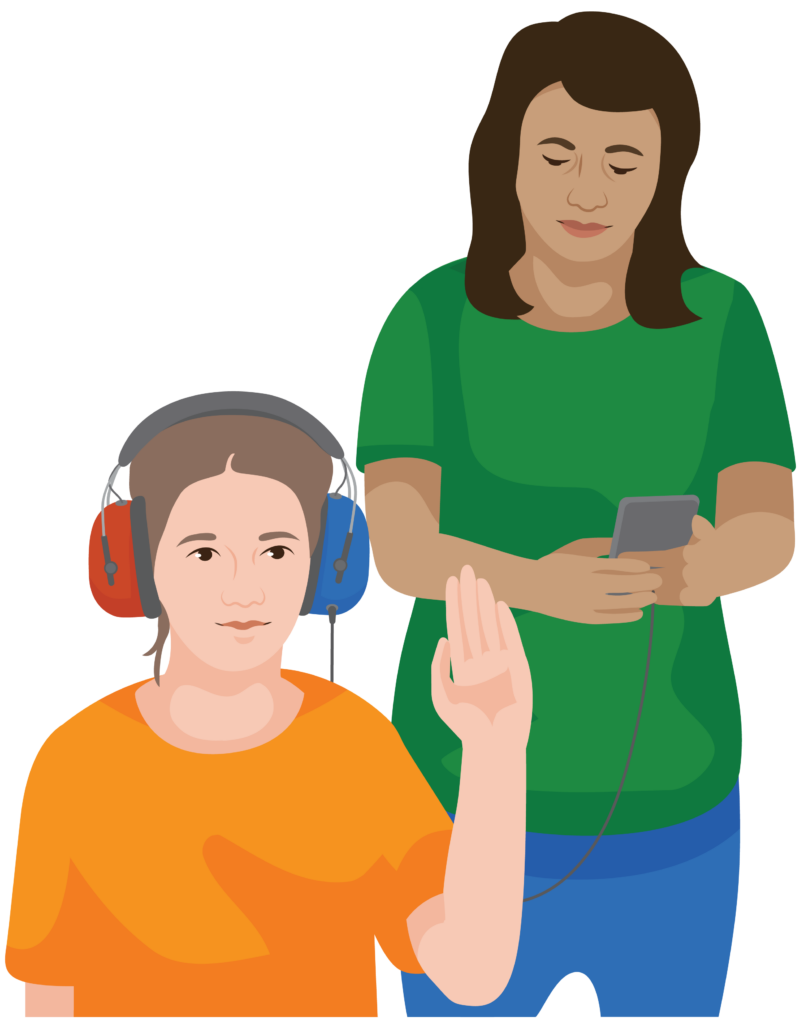
1. Объясните, как проходит проверка слуха
Объясните, что вы проверите слух ребенка, определив самый тихий звук, который он или она может расслышать (порог слышимости).
2. Попрактикуйтесь в реагировании на звуки
Сядьте напротив ребенка, чтобы он мог хорошо вас видеть.
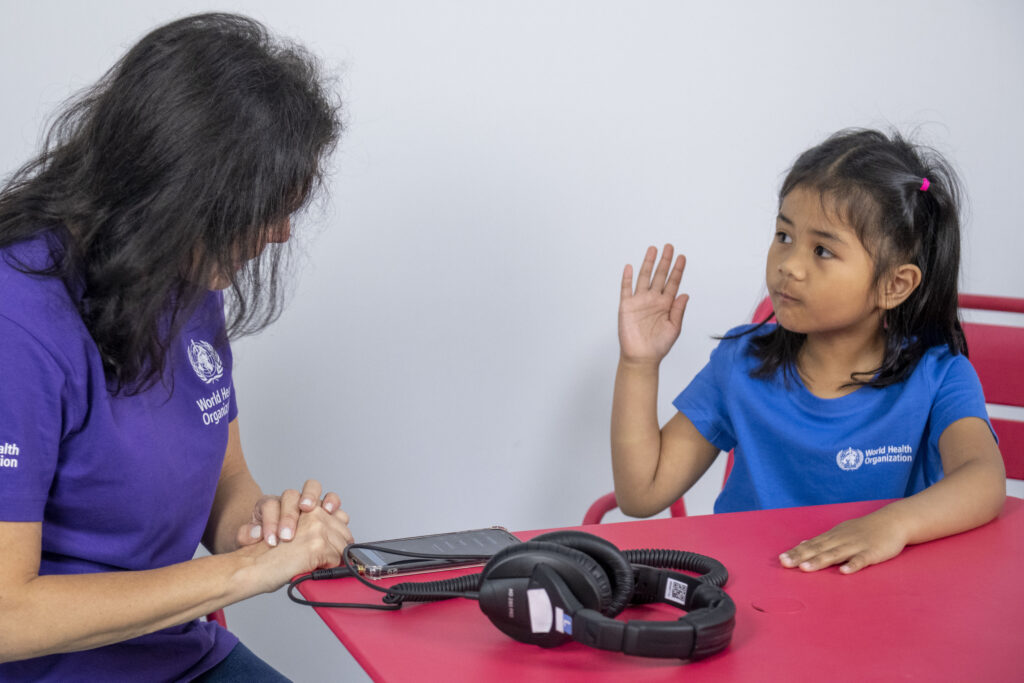
Поясните:
- Как только ты услышишь звук, нажми на кнопку для реагирования или подни руку с той же стороны, с которой раздался звук.
- Отпусти кнопку или опусти руку, как только перестанешь слышать звук
- Прежде чем надеть наушники, нужно потренироваться правильно реагировать на звуки
- Когда ребенок отреагирует, похвалите и поощрите его.
Совет
Если ребенок не реагирует на звуки в ходе тренировочной проверки, могут помочь следующие действия:
- Используйте игрушки или наклейки, чтобы заинтересовать ребенка в участии
- Измените способ реагирования, например, ребенок может помахать рукой или уронить игрушку, когда слышит звук.
- Покажите, что нужно делать, с помощью родителя или опекуна
- Покажите видео, на котором другой ребенок выполняет задание.
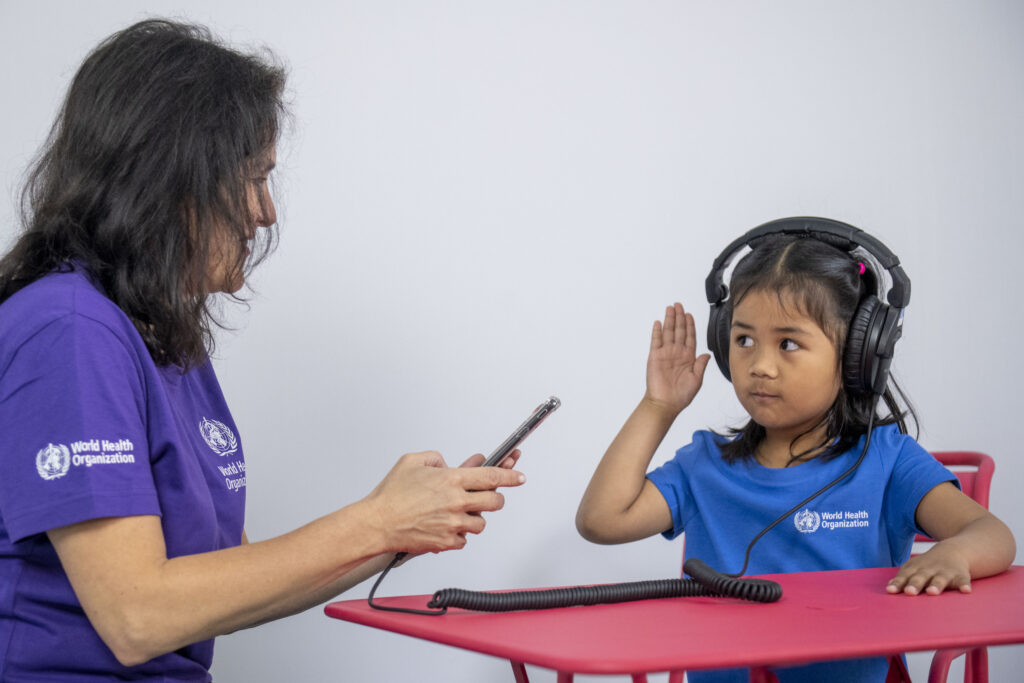
Сначала потренируйтесь с ребенком на частоте 1000 герц (Гц) и 40 децибел (дБ):
- Попросите ребенка надеть наушники с шумоподавлением
- Убедитесь, что наушники надеты правильно
- Потренируйтесь, подавая звук дважды в каждое ухо.
Совет
Если ребенок не слышит звук во время тренировочной проверки, увеличьте громкость на 10 дБ и повторите проверку.
3. Проведите проверку слуха
- Наденьте на ребенка наушники с шумоподавлением
- Убедитесь, что наушники надеты правильно
- Начните проверку с того уха, которым ребенок лучше слышит. Если неизвестно, какое ухо слышит лучше, начните с правого уха
- Установите частоту звука на 1000 Гц и интенсивность на 40 дБ.
Совет
Чтобы обеспечить более точные результаты проверки слуха:
- Расположитесь так, чтобы ребенок не мог вас видеть в тот момент, когда вы подаете звук в наушники
- Меняйте ритм подачи звуков. Это нужно для того, чтобы ребенок не пытался угадать, когда вы подадите следующий звук.
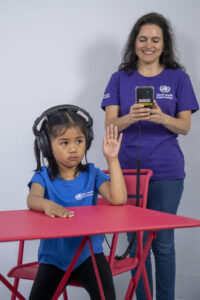
Звуки более высокой частоты (1000 Гц) обычно легче воспринимаются на слух и помогают ребенку почувствовать себя увереннее в начале проверки слуха.
- Нажимайте на кнопку в течение 2-3 секунд и посмотрите, поднимет ли ребенок руку:
- Если ребенок поднимает руку, уменьшите уровень громкости на 10 дБ.
- Если ребенок не реагирует, увеличьте уровень громкости на 5 дБ.
- Продолжайте, пока не определите самый тихий звук, который ребенок способен услышать:
- Повторите звук трижды, чтобы подтвердить порог слышимости.
- Если ребенок отвечает правильно хотя бы два раза из трех на данной частоте, запишите порог слышимости в Форму для проведения проверки
- Повторите тот же процесс на частотах 2000 Гц, 4000 Гц и 500 Гц
- Повторите весь процесс для левого уха ребенка.
Инструкция
Посмотрите видео о проверке слуха у ребенка.
Практическое задание
В группах попрактикуйтесь в проведении проверки слуха у ребенка, у которого нет потери слуха.
Подготовьтесь:
- Определите место, где будет проходить проверка слуха
- Проверьте уровень шума с помощью измерителя уровня звука или приложения hearWHO app:
- Нажмите на кнопку "Проверить слух", чтобы получить доступ к измерителю уровня звука
- Разрешите измерить уровень шума.
Проведите проверку:
- Поясните в дружественной к ребенку форме, как проходит проверка слуха
- Проведите проверку слуха на частотах 1000, 2000, 4000 и 500 Гц, начав с того уха, которым ребенок лучше слышит, или с правого уха
- Запишите самый тихий звук, который ребенок может расслышать на каждой частоте
- Повторите весь процесс с другим ухом.
Надежность проверки слуха
При проведении проверки слуха спросите себя о том, насколько вы уверены в точности результатов.
Вы можете считать результаты надежными, если ребенок:
- последовательно реагирует на предъявляемые звуки
- вам удалось определить порог слышимости применительно к каждой частоте.
Результаты вызывают сомнения или являются полностью недостоверными, если ребенок:
- реагирует на предъявляемые звуки бессистемно, случайно
- реагирует даже при отсутствии звука
- реагирует только тогда, когда видит, что сотрудник, проводящий проверку, совершает движения.
Если вы уверены в надежности результатов, продолжайте.
Если вы не уверены в надежности результатов проверки, после обсуждения с наставником направьте пациента к специалисту по здоровью слуха и уха.
Внимание
Точность результатов проверки важна для правильного программирования слуховых аппаратов.
4. Рассчитайте средний порог слышимости
- Вычислите среднее значение в дБ, сложив пороговые значения на частоте 500 Гц, 1000 Гц, 2000 Гц и 4000 Гц, а затем разделив результат сложения на четыре.
- Сравните среднее пороговое значение для правого и левого уха:
- разница составляет менее 15 дБ Продолжайте
- разница составляет 15 дБ или более Направьте пациента к специалисту по здоровью слуха и уха.
У детей с односторонней потерей слуха (только с одной стороны) и асимметричной потерей слуха (средние пороги слышимости у правого и левого уха отличаются более чем на 15 дБ) имеются более сложные потребности. Направляйте таких детей к специалистам по здоровью слуха и уха.
Инструкция
Ответьте на следующие вопросы, чтобы проверить, хорошо ли вы усвоили информацию из модуля TAP "Непрограммируемые слуховые аппараты".
Вопрос

Познакомьтесь с Анжу
Анжу шесть лет, и она ходит в школу.
Анжу прошла курс лечения от ушной инфекции. Вместе с родителями она внова пришла на прием в местный центр здравоохранения на проверку здоровья уха и слуха.
Медицинский работник проводит проверку здоровья ушей Анжу. Оба ее уха здоровы. Далее проводится проверка слуха. Во время проверки слуха Анжу реагирует уверенно.
Посмотрите, какие пороги слышимости были определены у Анжу на каждой частоте.
| Сторона | 500 Гц | 1000 Гц | 2000 Гц | 4000 Гц |
| Правая | 15 | 10 | 20 | 10 |
| Левая | 10 | 10 | 15 | 15 |
1. Каково значение среднего порога слышимости для правого уха Анжу?
Пиравильный ответ ‒ 13,75 дБ!
Это среднее значение, полученное при сложении всех чисел и делении результата на четыре.
2. Каково значение среднего порога слышимости для левого уха Анжу?
Правильный ответ ‒ 12,50 дБ!
Это среднее значение, полученное при сложении всех чисел и делении результата на четыре.
3. Составляет ли разница между правым и левым ухом Анжу менее 15 дБ?
Выберите один ответ.
Правильный ответ – "Да"!
Разница составляет менее 15 дБ. Вы можете продолжать.
Сверьтесь с таблицей "Степени потери слуха" в Форме для проведения оценки или ниже.
| Степень | Среднее значение |
| В пределах нормы | Среднее значение менее 20 дБ |
| Легкая потеря слуха | Среднее значение 20-34 дБ |
| Умеренная потеря слуха | Среднее значение 35-49 дБ |
| Умеренно тяжелая потеря слуха | Среднее значение 50-64 дБ |
| Тяжелая потеря слуха | Среднее значение 65-79 дБ |
| Глубокая потеря слуха | Среднее значение более 80 дБ |
4. Какова степень потери слуха на правое ухо у Анжу?
Выберите один ответ.
Правильный ответ ‒ "Слух в пределах нормы"!
Порог слышимости 13,75 дБ находится в пределах нормы.
5. Какова степень потери слуха на левое ухо у Анжу?
Выберите один ответ.
Правильный ответ ‒ "Слух в пределах нормы"!
Значение порога слышимости 12,50 дБ находится в пределах нормы.
5. Задокументируйте результаты по каждому уху
- Запишите средние значения остроты слуха в разделе Формы, посвященном проверке слуха.
- Задокументируйте оценку надежности проверки слуха.
- Запишите степень остроты слуха применительно к правому и левому уху.
Выполните действия, которые рекомендуется предпринять при такой степени потери слуха в соответствии с таблицей "Степени потери слуха".
Объясните результаты проверки слуха
Завершив проверку слуха и определив степень потери слуха у ребенка, разъясните результаты и сообщите выводы о том, будут ли ребенку полезны слуховые аппараты.
Помните ли вы Анжу?

Разъясните Анжу и ее родителям результаты проверки слуха. У Анжу нормальный слух. Ей не требуются слуховые аппараты.